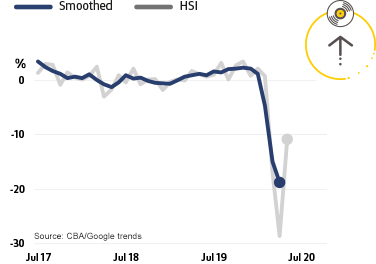The staged re-opening of the economy and the implementation of fiscal support policies are noticeably influencing household spending – according to the latest monthly Commonwealth Bank Household Spending Intentions (HSI) series, which includes data to the end of May 2020.
Commonwealth Bank Chief Economist Stephen Halmarick said: “We are seeing some big changes taking place in household spending that provide early signs of stabilisation and recovery in some parts of the Australian economy, largely driven by changes in government policy.
“Data up to the end of May 2020 showed retail spending intentions jumped higher on the month, consistent with our CBA credit and debit card spending data. Improvement was also seen in entertainment spending intentions. After big falls in April, spending intentions stabilised for home buying and travel. Health and fitness spending intentions also stabilised after recent gains, while some weakness was evident for education spending intentions and motor vehicle spending intentions.
Mr Halmarick says home buying spending intentions stabilised in May due to an increase in mortgage applications as house prices fell. “This was especially the case for owner-occupiers looking to lock in low fixed rate mortgages. Online Google searches related to home buying decreased in previous months and is in line with house price falls for the month.”
Travel spending intentions also stabilised in May as parts of the economy re-opened. “While Australians may not be able to holiday overseas until well into 2021, domestic tourism is likely to get a significant boost in coming months. Australians will no doubt be keen to visit family and friends around the country and use the opportunity to explore the best that Australia has to offer,” Mr Halmarick said.
Looking at the jump in retail spending intentions in May, Mr Halmarick says the key drivers were food, general retail (department and discount stores) and household furnishings and equipment. “It is also worth noting that a larger share of retail sales is now likely flowing through credit/debit card spending, rather than by cash.”
Entertainment spending intentions also improved in May, with the key driver being an improvement in ‘recreation’ spending. “Perhaps adding to coronavirus ‘waist-lines’, there was also an ongoing increase in spending on both alcohol for at home consumption, and confectionary. Weakness is still evident in alcohol sales at licenced premises, as well as restaurants, art galleries, live music venues, bowling allies, cinemas and theatres.”
“While we know that the Australian economy is in recession, the path to recovery is becoming clearer".
Monthly Household Spending Intentions

Each month, analysis by CBA’s Global Economic and Markets Research team provides an early indication of spending trends across seven key household sectors in Australia. In addition to home buying, the series covers around 55 per cent of Australia’s total consumer spend across; retail, travel, education, entertainment, motor vehicles, and health and fitness.
Retail Spending Intentions
|
Travel Spending Intentions
|
Home Buying Spending Intentions
|
Education Spending Intentions
|
Entertainment Spending Intentions
|
Motor Vehicle Spending Intentions
|
Health & Fitness Spending Intentions
|
Notes for Editors:
About our monthly Household Spending Intentions series
The HSI series offers a forward-looking view by analysing actual customer behaviour from CBA’s transactions data, along with household search activity from Google Trends.
The approach focuses on Australian households and their spending intentions. Employing near real-time spending readings from CBA’s household transactions data and combining them with relevant search information from Google Trends was used to map the data results on consumer spending. Households are the dominant part of the economy and drive much of its activity and volatility, and this combination adds to insights on prospective household spending trends in the Australian economy.
Google Trends is a publically available service that enables people to explore search trends around the world. These searches provide insights into what consumers are doing/researching on the Internet and what their spending intentions are.
CBA’s Household Spending Intentions series is published on the third Tuesday of every month. To find out more about the series, visit www.commbank.com.au/spendingintentions.
Read the latest Household Spending Intentions report.
Disclaimer
The ‘CBA Household Spending Intentions’ series and “CBA credit and debit card spend” reports provide general market-related information, and are not intended to be an investment research report. These reports have been prepared without taking into account your objectives, financial situation (including the capacity to bear loss), knowledge, experience or needs. Before acting on the information in these reports you should consider the appropriateness and, if necessary seek appropriate professional or financial advice, including tax and legal advice. The data used in the ‘CBA Household Spending Intentions’ series is a combination of the CBA Data and Google Trends™ data. Google Trends is a trademark of Google LLC. Where ‘CBA data’ is cited, this refers to the Bank proprietary data that is sourced from the Bank’s internal systems and may include, but not be limited to, credit card transaction data, merchant facility transaction data and applications for credit. The Bank takes reasonable steps to ensure that its proprietary data used is accurate and any opinions, conclusions or recommendations are reasonably held or made as at the time of compilation of this report. As the statistics take into account only the Bank’s data, no representation or warranty is made as to the completeness of the data and it may not reflect all trends in the market. All customer data used or represented in this report is anonymous and aggregated before analysis and is used and disclosed in accordance with the Commonwealth Bank Group’s Privacy Policy Statement.
Commonwealth Bank of Australia ABN 48 123 123 124 AFSL 234945.










